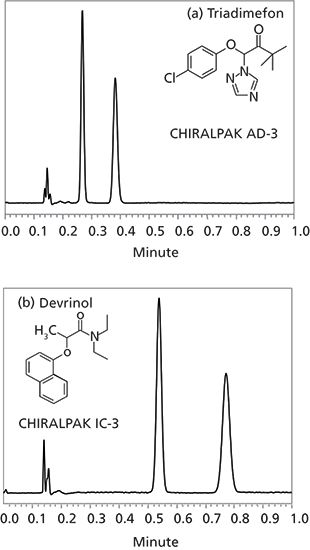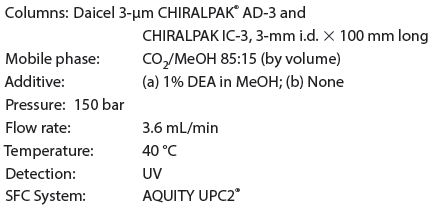High-Speed SFC Enantiomeric Separation Using the Optimal Daicel SFC Chiral Columns
The Application Notebook
Supercritical fluid chromatography (SFC) is an evolutionary technology and a powerful tool for enantiomer separation when used in combination with chiral stationary phases (CSPs).
Supercritical fluid chromatography (SFC) is an evolutionary technology and a powerful tool for enantiomer separation when used in combination with chiral stationary phases (CSPs).
In parallel to the recent advancements in SFC instruments, there has been significant evolution of chiral columns in terms of CSP enantioselectivity, versatility, column stability, and efficiency. In order to provide optimal SFC chiral columns for ultra-fast analysis, the product line of chiral columns based on polysaccharide derivatives has recently been extended to new column dimensions.

Figure 1: Examples of fast chiral analysis by SFC.
Experimental and Discussion
As shown in the separation examples, Daicel chiral columns packed with 3-µm CSP particles and sized to 3.0-mm i.d. × 100 mm long can take full advantage of state-of-the-art SFC instrumentation to achieve fast and ultra-fast chiral separations without compromising the optimal resolution of enantiomers. These beneficial properties can be attributed to the high enantiorecognition ability of the CSPs, van Deemter fast mass-transfer kinetics, column packing stability, and the selection of column diameter.
Chromatographic Conditions

CHIRALPAK is a registered trademark of Daicel Corporation

Chiral Technologies, Inc.
800 North Five Points Road, West Chester, PA 19380
tel: 610-594-2100 Fax: 610-594-2325
Website: www.chiraltech.com

SEC-MALS of Antibody Therapeutics—A Robust Method for In-Depth Sample Characterization
June 1st 2022Monoclonal antibodies (mAbs) are effective therapeutics for cancers, auto-immune diseases, viral infections, and other diseases. Recent developments in antibody therapeutics aim to add more specific binding regions (bi- and multi-specificity) to increase their effectiveness and/or to downsize the molecule to the specific binding regions (for example, scFv or Fab fragment) to achieve better penetration of the tissue. As the molecule gets more complex, the possible high and low molecular weight (H/LMW) impurities become more complex, too. In order to accurately analyze the various species, more advanced detection than ultraviolet (UV) is required to characterize a mAb sample.















